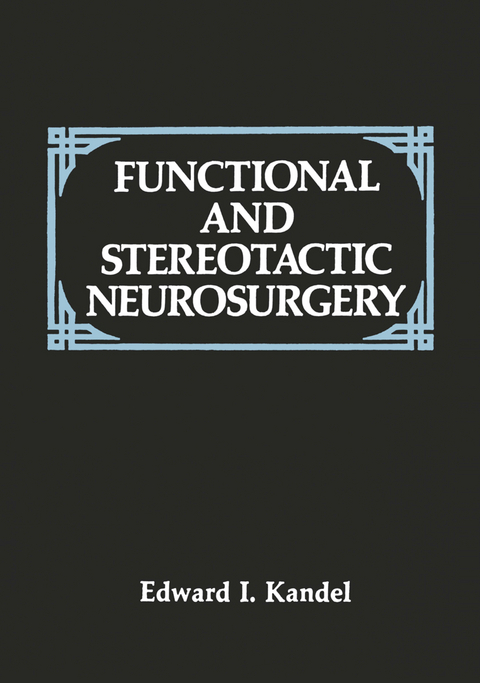
Functional and Stereotactic Neurosurgery
Springer-Verlag New York Inc.
978-1-4612-8040-8 (ISBN)
Foreword.- Preface.- Abbreviations.- 1 Anatomy of Subcortical Structures Related to Stereotaxy.- 1. Extrapyramidal System.- 2. Limbic System.- 3. Cerebellum.- 4. Pain Structures and Pain-Conducting Pathways of the CNS.- 2 Extrapyramidal Mechanisms.- 1. General Remarks.- 2. Tremor.- 3. Rigidity.- 4. Spasticity.- 5. Akinesia.- 3 Stereotactic Method.- 1. Historical Note.- 2. General Principles.- 3. Individual Variability.- 4. Stereotactic Atlases.- 5. Stereotactic Instruments.- 6. Computer Techniques.- 7. Stereotaxis and Computerized Tomography.- 8. Stereotaxis and Nuclear Magnetic Resonance.- 9. Stereotaxis and Digital Subtraction Angiography.- 10. Combined Visualization Techniques.- 11. Stereotaxis and Ultrasound.- 4 Principles of Stereotactic Operations on Subcortical Structures 1.- 1. General Considerations.- 2. Anesthesia.- 3. Location of the Burr Hole.- 4. Visualization of the Ventricular System.- 5. Stereotactic Coordinates.- 7. Functional Control.- 5 The Production of Lesions in Stereotactic Operations.- 1. General Principles.- 2. Local Freezing.- 3. Electrical Methods.- 4. Radioactive Isotopes.- 5. Laser Techniques.- 6. Remote Control Methods.- 7. Chemical Methods.- 8. Mechanical Methods.- 6 Parkinsonism.- 1. Historical Note.- 2. Epidemiology.- 3. Mortality.- 4. Etiology.- 5. Pathological Anatomy.- 6. Pathogenesis.- 7. Clinical Picture.- 8. Indications and Contraindications for Surgery.- 9. Surgery.- 10. Stereotactic Surgery.- 11. Prevention and Treatment of Postoperative Complications.- 12. Personal Observations.- 13. Concluding Remarks.- 7 Dystonia Musculorum Deformans.- 1. Historical Note.- 2. Etiology.- 3. Pathology.- 4. Pathogenesis.- 5. Clinical Investigation.- 6. Biochemical Pathogenesis.- 7. Clinical Aspects.- 8. Indications and Contraindications for Surgical Treatment.- 9. Surgical Treatment.- 10. Stereotactic Operations.- 11. Personal Observations.- 8 Spasmodic Torticollis.- 1. Introduction.- 2. Etiology.- 3. Pathology.- 4. Pathogenesis.- 5. Clinical Picture.- 6. Stages of the Disorder.- 7. Other Manifestations of ST.- 8. Differential Diagnosis.- 9. Surgical Treatment.- 10. Personal Observations.- 11. Summary.- 9 Cerebral Palsy.- 1. Introduction.- 2. Etiology.- 3. Pathology and Pathogenesis.- 4. Clinical Aspects.- 5. Surgical Treatment.- 6. Personal Observations.- 10 Hemihyperkinesias.- 1. Introduction.- 2. Etiology and Pathogenesis.- 3. Clinical Features.- 4. Stereotactic Surgery.- 5. Personal Observations.- 11 Multiple Sclerosis.- 1. Introduction.- 2. Surgical Treatment.- 3. Personal Observations.- 12 Hereditary Degenerative Disorders.- 1. Introduction.- 2. Hepatocerebral Dystrophy (Wilson’s Disease).- 3. Huntington’s Chorea.- 4. Essential Tremor.- 5. Hunt’s Cerebellar Dyssynergia.- 6. Myoclonus and Myoclonus Epilepsy.- 13 Pain.- 1. General Remarks.- 2. Gate Control Theory.- 3. Antinociceptive System.- 4. Pathogenesis of Chronic Pain.- 5. Surgical Management of Pain.- 6. Central Pain Syndromes.- 6.2. Phantom Pain Syndrome.- 6.3. Causalgia.- 7. Trigeminal Neuralgia.- 8. Neuralgia of the Glossopharyngeal Nerve.- 9. Convulsive Tic.- 10. Occipital Neuralgia.- 11. Migrainous Neuralgia.- 12. Hemifacial Spasm.- 14 Epilepsy.- 1. General Remarks.- 2. Etiology.- 3. Pathogenesis.- 4. Epileptogenic Focus.- 5. Diagnostic Procedures.- 6. Surgical Treatment.- 15 Brain Tumors.- 1. Introduction.- 2. Stereotactic Biopsy.- 3. Stereotactic Biopsy with Computed Tomography.- 4. Stereotactic Destruction.- 5. Pituitary Tumors.- 6. Stereotactic Destruction of the Normal Hypophysis.- 16 Cerebral Arterial Aneurysms and ArteriovenousMalformations.- 1. Introduction.- 2. Arterial Aneurysms.- 3. Arteriovenous Malformations.- 4. Stereotactic Clipping of Aneurysms.- 17 Spontaneous Intracerebral Hematomas.- 1. Introduction.- 2. Improved Technique.- 3. Experimental Tests.- 4. Preoperative Calculations.- 5. Operative Technique.- 6. Clinical Results.- 7. Summary.- 18 Mental Disorders.- 1. Introduction.- 2. Stereotactic and Functional Operations.- 3. Surgical Treatment of Mental Disorders.- 19 Spinal Cord Disorders.- 1. Introduction.- 2. Spasticity.- 3. Bladder Dysfunctions.- 4. Phrenic Nerve Stimulation.- 20 Additional Possibilities of Stereotactic Neurosurgery.- 1. Introduction.- 2. Ventriculoscopy.- 3. Removal of Foreign Bodies.- 4. Obstructive Hydrocephalus.- 5. Reconstruction of the Sylvian Aqueduct.- 6. Relief of Nystagmus.- 7 Treatment of Obesity.- 8. Relief of Writer’s Cramp.- 9. Treatment of Raynaud’s Disease.- 10. Relief of Erythromelalgia.- Epilogue.- References.
| Zusatzinfo | 724 p. |
|---|---|
| Verlagsort | New York, NY |
| Sprache | englisch |
| Maße | 178 x 254 mm |
| Themenwelt | Sachbuch/Ratgeber ► Natur / Technik ► Garten |
| Medizinische Fachgebiete ► Chirurgie ► Neurochirurgie | |
| Medizin / Pharmazie ► Medizinische Fachgebiete ► Neurologie | |
| Naturwissenschaften ► Biologie ► Humanbiologie | |
| Naturwissenschaften ► Biologie ► Zoologie | |
| ISBN-10 | 1-4612-8040-0 / 1461280400 |
| ISBN-13 | 978-1-4612-8040-8 / 9781461280408 |
| Zustand | Neuware |
| Informationen gemäß Produktsicherheitsverordnung (GPSR) | |
| Haben Sie eine Frage zum Produkt? |
aus dem Bereich


